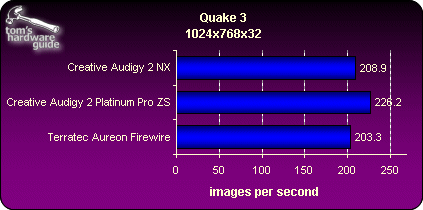Terratec's Aureon 7.1 FireWire Attempts Plug-and-Play with Pro Sound Card Performance
Games And 3D
USB sound cards don't have a particularly good reputation for use with games because they are hungrier than a good internal card when it comes to taking up processor space. It was thus interesting to see how the Aureon FireWire behaved in comparison with our current reference equipment, Creative Audigy's 2 ZS internal card, as well as against a USB 2.0 Creative Audigy 2 NX. We didn't choose these options at random, of course. All of them are 7.1 cards like the Aureon FireWire card, which meant that the comparison was on an equal footing. When you reduce the number of output channels, you also reduce the complexity of calculation and thus the extent of processor load. It must be stated, however, that Aureon FireWire is limited to EAX 2.0 like all the other cards not made by Creative, while our two reference cards offer EAX 3.0 or 4.0, producing more developed sound effects, at least in games that take these versions into account. Absolute equality of processing would be difficult, because games automatically detect the capabilities of the card being used.
Tests using RightMark 3Dsound, in comparison with the Audigy 2NX, showed a much lower processor load in DS3D as well as in EAX. So this point was satisfactory as might have been expected.
In practice, testing with our standard games showed that the Aureon FireWire card had a clear advantage. In an Audigy 2 ZS (an internal card) still leads the way, the comparison with the Audigy 2 NX (USB) was not so clear. The Creative came out best for Quake 3 as well as for Comanche 4, but Aureon FireWire had a clear advantage with Splinter Cell. That makes it hard to draw firm conclusions but the Aureon FireWire card does not seem to able to make significant inroads as far as games are concerned.
Get Tom's Hardware's best news and in-depth reviews, straight to your inbox.
Current page: Games And 3D
Prev Page Behavior At 24 Bits/96 KHz Next Page An Advantage: Stand-alone Operation


